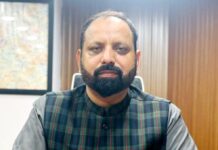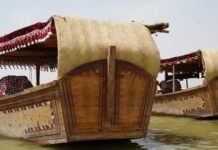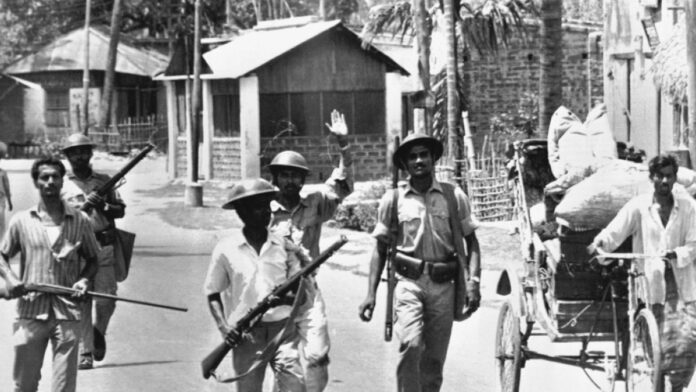The dramatic developments in Bangladesh after the students defied the army’s curfew orders and marched on Prime Minister Sheikh Hasina Wajid’s official residence, compelling her to flee to India, and establishment of the interim government have exposed the myth of democracy in the country.
Indian Prime Minister Narendra Modi, with his Bangladeshi counterpart, Sheikh Hasina, met in New Delhi in June, this year. Since early July, this year, at least 650 people were killed in the deadly protests, which ended the autocratic rule of 76-year-old Prime minister Sheikh Hasina.
The international community must uphold human rights and support the Bengali peoples’ quest for self-determination and unity. The 1971 Liberation War’s legacy highlights their resilience and enduring aspiration for a unified identity. Despite political challenges, the spirit of the Bengali people remains strong, striving to realise their cultural and national aspirations
Clashes escalated despite a round-the-clock curfew and the deployment of soldiers, as Hasina had sought to quell nationwide protests against her government. But, she failed badly.
University students built barricades blocking roads and railway lines to demand reforms to a quota system for sought-after public sector jobs. They said the scheme was used to stack the civil service with loyalists of Hasina’s ruling Awami League party.
After the PM’s ouster Bangladesh’s army chief Gen Waker-Uz-Zaman took charge and formed an interim government.
General Waker and Bangladeshi President Mohammed Shahabuddin ordered the release of the jailed former prime minister and key opposition leader Khaleda Zia. chairperson of the Bangladesh Nationalist Party (BNP).
The military freed all the people who had been arrested during the student protests.
Now, the interim government headed by Nobel Peace Prize laureate Muhammad Yunus has been established, and started to take measures against corruption and to ensure public safety. Student leaders are also participating in the interim government as advisers. The country will hold an election after setting up a democratic system.
Notably, during the protests, Bangladeshis were raising slogans in support of Pakistan and against India.
The recent violent suppression of student protests in Bangladesh had exposed the authoritarian tendencies of Prime Minister Sheikh Hasina’s government, who won a fifth term as prime minister in January after a vote without genuine opposition.
In January, 2024, after Hasina claimed victory in a one-sided election with many of her opponents in jail, Indian officials endorsed the election results.
Members of the Bangladeshi Hindu community held banners and chanted slogans against violence targeting the country’s minorities during a protest in Dhaka. The main purpose of New Delhi was to take Bangladesh towards civil war.
Meanwhile, a video was shared by an account called ‘Trunicle’, showing protesters chanting, “Pakistan is in our Blood”.
Analysts opine: “Some may try to exploit the past, questioning Bangladesh’s allegiance due to India’s role in its creation, this propaganda falls flat. The truth is, Sheikh Mujibur Rahman and his Mukti Bahini sowed seeds of discord, but today, both Pakistan and Bangladesh recognise the real enemies as Sheikh Mujibur Rahman, Mukti Bahini and now Mujib’s daughter Shaikh Hasina Wajid who seek to divide us”.
In fact, on 16 December 1971, Pakistan was dismembered and the new state of Bangladesh was created as part of the Indian collusion which still continues in Pakistan’s Balochistan province.
In this context, Asoka Raina in his book, Inside RAW: The Story of India’s Secret Service disclosed: “Indian intelligence agencies were involved in erstwhile East Pakistan…its operatives were in touch with Sheikh Mujib as the possible ‘Father’ of a new nation…Bangladesh, who went to Agartala in 1965. The famous Agartala case was unearthed in 1967. In fact, the main purpose of raising RAW in 1968 was to organise covert operations in Bangladesh. Indian army officers and RAW officials used Bengali refugees to set up Mukti Bahini…RAW had established the network of a separatist movement through ‘cells’ within East Pakistan and military training camps in Indian territory adjoining East Pakistan…carrying out acts of sabotage against communication lines so that Indian forces simply marched in at the ‘right’ time…conducting unconventional guerrilla acts against the Pakistani defence forces.”
Hence, since the PM of Bangladesh, Sheikh Hasina, daughter of Sheikh Mujib, came into power, New Delhi had been employing various tactics to entrap Bangladesh by manipulating her pro-Indian tilt against Islamabad and even against the people of Bangladesh. In this connection, 42 years after the events of 1971, Abdul Qadir, the leader of Jamaat-e-Islami (JI) was hanged because of his loyalty to Pakistan. Executions of Mujadid and Chaudry of JI were also part of the same scheme.
Ironically, the Awami League’s so-called nationalism was based on fabricated figures about the killing of three million Bengali people by the Pakistan Army in 1971. This figure was never authenticated by independent researchers.
A famous Bengali journalist Sarmila Bose authored the book Dead Reckoning: Memories of the 1971 Bangladesh War after thorough investigation. She terms the number a gigantic rumour. Richard Sisson and Leo E Rose, in a book titled War and Secession: Pakistan, India and the Creation of Bangladesh clearly pointed out that the figures of the so-called genocide were faked by India.
Addressing a ceremony during his Bangladesh tour, Indian Prime Minister Modi openly stated on 7 June 2015 that Indian forces helped Mukti Bahini to turn East Pakistan into Bangladesh. He elaborated that former prime minister Atal Bihari Vajpayee had played an active role in separating East Pakistan, and he (Modi) had also come to Delhi in 1971 to participate in the Satyagraha Movement, launched by Jana Sangh, as a volunteer to garner support for the Mukti Bahini.
The partition of the Indian Subcontinent in 1947 was a monumental event that reshaped South Asia’s political and social landscape. This division, primarily driven by the Muslim League’s demand for a separate homeland for Muslims, led to the creation of two independent nations: India and Pakistan. India emerged as a secular republic, but over the years, its political landscape has increasingly been shaped by the rise of Hindu nationalism, particularly under the BJP . This shift had significant implications for India’s secular fabric and its religious and ethnic minorities.
Pakistan, on the other hand, was born as a geographically bifurcated state, with East and West Pakistan separated by approximately 1600 km of Indian territory. This peculiar arrangement was fraught with challenges, as the two wings of Pakistan were not only separated by geography but also by distinct cultural, linguistic, and economic differences. East Pakistan, predominantly inhabited by Bengali-speaking people, harbored a unique cultural identity which often clashed with the political and economic dominance of West Pakistan.
Despite constituting a majority of the population, the Bengalis of East Pakistan were consistently underrepresented in political leadership and faced systemic discrimination. These grievances culminated in a widespread movement for autonomy, spearheaded by the Awami League under the leadership of Sheikh Mujibur Rahman. The struggle for autonomy reached its zenith in 1971, leading to a brutal conflict known as the Bangladesh Liberation War.
The war concluded with the emergence of Bangladesh as an independent nation on 16 December 1971.
In spite of achieving independence, the dream of a unified Bengali nation remains unfulfilled. The arbitrary border that divides Bengal continues to separate families, communities, and a shared cultural heritage. West Bengal, which remained a part of India, and Bangladesh share deep-rooted historical, linguistic, and cultural ties which transcend political boundaries. Many Bengalis on both sides of the border envision a future where the artificial divide is erased, allowing for greater cultural and economic integration.
The love for Bengali culture and language is a profound force which unites Bengalis across borders. The Bengali language, with its rich literary and artistic heritage, is a source of immense pride for Bengalis. Rabindranath Tagore, the first non-European Nobel laureate in Literature, Rabinranath Tasgore, and Kazi Nazrul Islam, the national poet of Bangladesh, are celebrated figures who symbolize the cultural renaissance of Bengal.
For Bengalis on both sides of the border, “Durga Puja” and “Pohela Boishakh” are major celebrations that reinforce their shared cultural identity. Durga Puja, a vibrant festival, celebrates the triumph of good over evil through the goddess Durga’s victory over the demon king Mahishasura, featuring enthusiastic celebrations and elaborate rituals. Pohela Boishakh, marking the Bengali New Year on April 14th or 15th, signifies renewal, joy, and cultural pride. Both festivals unite Bengalis in their cultural and religious traditions, transcending geographical boundaries.
Many Bengalis yearn for a separate Bengali nation which reflects their unique cultural and linguistic identity. This aspiration is fueled by the deep emotional and historical connections, which binds Bengalis together, as well as a desire to preserve and promote their cultural heritage in a world that often overlooks regional identities in favour of broader national narratives.
These sentiments occasionally catch the attention of the Indian political elite, who are becoming increasingly aware of the growing emphasis on Hindu nationalism and identity by the BJP. As India’s political landscape shifts, concerns arise about the preservation of the diverse cultural fabric which had been a hallmark of the Indian subcontinent. The rise of Hindu nationalism has prompted discussions about the need to protect and promote regional identities, including that of the Bengali people.
As India drifts away from its secular roots under the BJP’s rule, and embraces a more religious identity aligned with Hindutva ideology, the urgency for the Bengali people to strive for unification and the full realisation of their liberation became even more pronounced. So, it is imperative that the Bengali people should continue to work towards unifying East and West Bengal, comprehending their aspirations for a united cultural and linguistic identity.
The international community must uphold human rights and support the Bengali peoples’ quest for self-determination and unity. The 1971 Liberation War’s legacy highlights their resilience and enduring aspiration for a unified identity. Despite political challenges, the spirit of the Bengali people remains strong, striving to realise their cultural and national aspirations.























